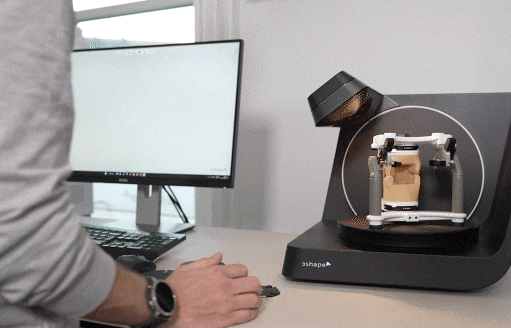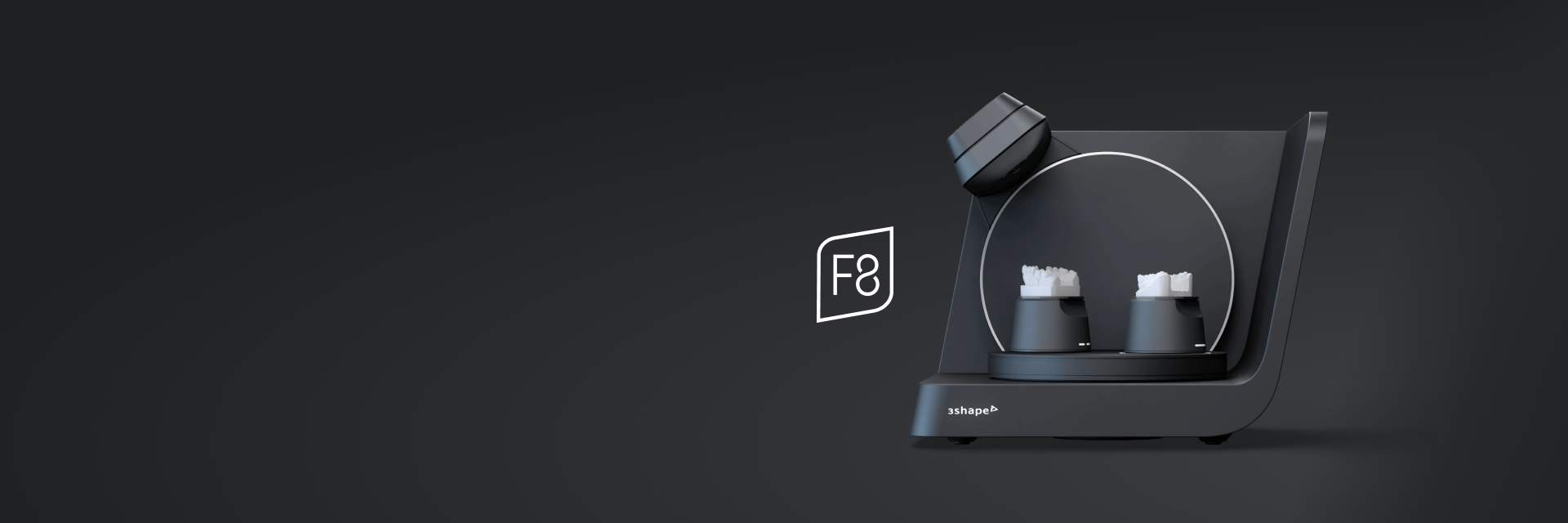“My goal is to get my team to be more efficient. I had major growth the last two years and just hired and hired to have hands to help. Now I need those hands to become more skilled and efficient.” Erin Marks
- Home
- Blog
- Digital dentistry
- Powerful lab scanner efficient
Why this powerful scanner will make your lab more efficient
As a CDT and former lab owner, a memory that really stands out for me was always having deadline pressure hanging over me. The stress of knowing that anything that came in my door needed to get back out the door fast.
It’s a hard way to work. But as a lab, you are constantly dealing with pressure because you need to work fast and keep your business competitive. Efficiency is everything. I know that I am not alone in feeling this pressure.
In a recent article by Kelly Fessel Carr and based on an LMT lab survey she stated that gaining efficiency is the top objective for many owners in 2023.
In that same article, Finer Dental Lab owner, Erin Marks, says
As a lab, we are always looking for little ways that can save us a minute here or a second there. Is it the software, the scanners, procedures? Where can we cut a minute?
Lab owner, Lee Culp recently told us that “for a lab, every second counts.”
Bringing the efficiency perspective into product development
When I joined 3Shape as a solution manager for its lab team, I was able to bring this perspective or insight into our product development. 3Shape’s goal has always been to make workflows more efficient for labs and practices. And luckily, there have been plenty of dental lab professionals working here and alongside us to ensure that we deliver solutions to meet these needs.
But recently, we launched a new solution that can really help labs be more efficient. It is the F8 lab scanner.
Let me explain why I think the F8 is a terrific new solution for labs. And I’ll tell you why, not as a 3Shape employee, but as a lab technician that knows what it’s like to have a deadline.
Life in the lab is non-stop
As a lab technician, you are never idle. If you are the lucky one operating the lab scanner, you spend most of your time fiddling around with the scanner. You are preparing models to put into the scanner, playing with blu tack, and maybe trying to figure out how to scan a triple tray … you are also just spending time taking the models in and out of the scanner.
You also need to be working with the scanning software, telling it what to do—correcting scans, re-scanning, relabeling files, and waiting for one scan to finish so you can start the second one. It’s non-stop.
Optimizing your scanning workflow
When 3Shape introduced the D2000 lab scanner back in 2015, we sought to help labs optimize their scanning workflows. The D2000 enabled you to scan two models at once. The idea that you could capture both the upper and lower models, all inserted dies and occlusion information in one scan, would eliminate many steps in the workflow.
Every lab scanner can scan fast
The problem with the D2000 was that something got in the way – namely, a door and roof. That’s where the F8 comes in. Seven years of scanning software development doesn’t hurt either!
If you have worked with our latest line of lab scanners, the Red E series, you know how fast they can scan. If you look across the industry, you also know that nowadays, every lab scanner can scan fast. There’s not much difference in seconds between the top scanner models.
That’s where my lab tech experience came into play. We posed the question:
What else could we do to help labs optimize their scanning workflows if the scanners can’t scan much faster? How can we make the total workflow faster?
We took what we did with the D2000, applied it to an E scanner design, cranked up the power and speed, and came up with the F8.
The F8 lab scanner
The F8 is a dual model lab scanner with the crazy scanning speeds of our E series but with a couple of significant differences:
- For one, you can scan two models at once, hence the name, dual model scanner.
- And two, there is no door or roof to the scanner, so you can scan models still in the articulator upright or standing triple trays.
- There are also some other huge differences in terms of eliminating steps and how much you need to interact with the scanner, which I will explain.
Making your scanning workflows more efficient

As mentioned earlier, if you are the lucky one responsible for scanning at your lab, then you are spending your time with one hand in and out of the scanner and the other on the keyboard and mouse. And you are doing that a lot. It’s not the most efficient way to work.
The F8 reduces your interactions
What the F8 does is reduce the amounts of times you need to interact with the scanner. For example, let’s say you are scanning upper and lower quads. With the F8, you place the upper and lower models on their respective plates. As soon as you remove your hand, the F8 instantly starts to scan the two models. You’re done.
The software also keeps track of what you are doing and automatically identifies each scan as upper or lower—no need to switch models or fiddle around in the software.
Full articulator workflow
Scanning an articulator is possible in many scanners, but it’s a pain. With the F8, you only have to scan the upper and lower models (at once because of its dual model design). Then insert the articulator plate and scan, then the articulator and scan.
That’s only three interactions with the F8 compared to what is, most likely, eight interactions with another scanner.
Not to mention that there’s no need to try and secure the articulator from flying around in the scanner during the scanning.
Here is another scanning workflow that the F8 truly optimizes. If you need to scan a triple tray and die, it’s one interaction with the F8. Place the die and triple tray on their respective plates (there are two, remember). That’s it. The F8 will automatically start scanning once you remove your hand and you are done.
How the F8 scans
This brings me to one of the game changers about the F8: how the scanning camera moves and takes images.
With lab scanners, the camera usually sits still, and the model moves around so the camera can take the images. With our E series, the scanner rocks the model back and forth while rotating the model around so that the camera can capture all the angles.
Some of the other scanner brands even move the model vertically up and down to get the different camera angles, making your blu tack skills pretty important.
If you are like me, you have experienced a falling or model breaking while scanning.
Like an interactive ride compared to a bouncy rollercoaster

Now the F8 eliminates this. The F8’s camera is attached to an arm that moves around to take a 360 image of the model while it gently rotates it in the scanner. When scanning an articulator in the F8, there’s no need to fasten it with a seatbelt. That's because the F8 does not tilt the articulator, it softly rotates it. The camera moves around the rotating articular to get a 360 scan of it.
The F8 is like a Disneyland interactive ride compared to one of their rollercoasters. You might think you are moving but are not, and your keys will not fall out of your pockets. Or in this case, the articulator or models will not drop anywhere while being scanned.
Less interaction means less pressure on the job
The F8 ticks all the boxes as a lab technician to make my scanning workflows more efficient. I can do other things while I leave the F8 to scan, and it enters the data correctly in my software.
I don’t need to have my hand in and out of the scanner, especially with its dual model scanning and auto start when scanning.
I’m also not worried about my models’ breaking during the rollercoaster ride.
In the LMT article I mentioned earlier, Randi James, President of Renstrom Dental Studio, Inc., said that his lab’s main goal was to “keep a healthy balance for our team while keeping quality and service at the forefront of our business. There have been so many pressures and unknowns post-Covid that we hope to push that all aside and get into a groove where we are able to be comfortable and enjoy work every day. We believe that reflects heavily in the work we do, and doctors and patients will reap the benefits as well.”
Make your technician’s day less stressful
This is an admirable philosophy and one that I wish my lab had achieved. As a lab technician, the F8 can go a long way in making your technicians' days less stressful and your work more predictable with its superior accuracy.
As a 3Shape solution manager, I am proud of the F8. It delivers on what lab technicians, our team, and I want from a lab scanner.
Come by our booth at the next dental show and try the F8 out. You will be surprised and relieved.
- Home
- Blog
- Digital dentistry
- Powerful lab scanner efficient
